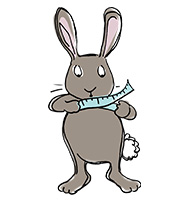
This is probably the most important thing to consider when looking after pet rabbits. A large proportion of the veterinary problems we see in rabbits are related to improper feeding which leads to dental disease, gut disorders, obesity and so on.
Rabbits have a very high need for dietary fibre, and have a ‘double digestion’ system, whereby food material goes through the digestive system twice. They pass two different sorts of droppings: caecotrophs (sticky faeces) which are usually eaten directly from the anus, and hard pelleted droppings. If the rabbits do not eat the first faeces (e.g. due to obesity, dental problems, arthritis etc.) then dietary issues can result.
Rabbit diets should be high in fibre, low in fat, starch and sugars with a moderate protein level, and with an abrasive action on the teeth. The ideal is grass and hay! These alone however, are not usually practical in a home setting, and so supplementary rabbit foods can be offered.
Muesli-type rabbit mixes are not recommended as these are generally low in fibre and allow selective eating, whereby the rabbit will pick and choose which bits to eat. Extruded pelleted diets, such as Burgess Excel, are better as each pellet is the same. These should still be considered ‘supplementary’ in that the majority of the diet should be fresh good quality hay plus leafy greens and vegetables. Treats such as fruit, ‘choc drops’ and other high sugar foods should be avoided. A recommended diet is unlimited hay, leafy greens and vegetables plus a small proportion of pellets.
Rabbits’ teeth (both incisors and cheek teeth) are constantly growing and need to be worn down by chewing. Wild rabbits will spend a lot of their time chewing and grinding down high fibre foods such as grass. If pet rabbits do not have the opportunity to do the same (e.g. if they are eating small amounts of muesli-type rabbit food and no hay or grass), then the teeth will wear abnormally and mouth pain will result due to sharp edges rubbing against the tongue and cheeks. Dental treatment can help, but once dental disease progresses, regular treatment is necessary and even then the problem is likely to get worse over time, shortening the rabbit’s lifespan.
Lack of dietary fibre will also lead to boredom (not spending as much time chewing) and gut problems such as gut stasis (fibre is needed to keep the guts moving). If a rabbit stops eating for as little as 24 hours, veterinary attention should be sought as serious gut issues can ensue. Rabbits’ diets should not be changed suddenly for the same reason – any changes should be made very gradually over 1 - 2 weeks.
Low fibre and high starch and sugary diets can lead to obesity – very common in pet rabbits. This will have knock-on effects with a higher risk of heart and joint disease, development of sores on the rabbit's hindpaws, difficulty in eating caecotrophs, leading to more nutritional problems and the risk of fly-strike and so on. If you are concerned about your rabbit’s weight and would like to discuss diet with the vets or nurses, please contact the surgery.
Care should be taken to avoid access to certain toxic plants such as busy lizzies, carnations, yucca and laburnum – contact us if you have any queries on which plants are considered toxic.
Fresh clean water should always be provided, either in a dropper bottle or bowl. Care should be taken to make sure that this does not freeze if outdoors during the winter. Recent research has shown that rabbits prefer to drink from bowls rather than bottles, so bowls may be better in terms of improving hydration, as long as they can be kept clean.
Join our Pet Health Club to save 10% on the cost of Excel rabbit life-stage diets and Excel hays.